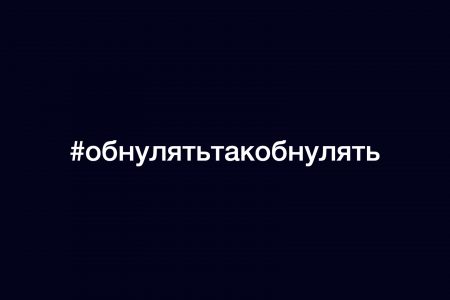video action (fixed media)
Do red and green candies actually have different tastes? Do we indeed eat with our eyes first? In this installation, the audience is invited to explore the relationship between colour, smell, fragrance, and flavor by watching, smelling, tasting, and feeling candies, meditating on the nature of our perception. This interactive installation, titled ‘Meditation on Skittles,’ unfolded on February 7, 2022, as part of the Liminal Spaces multimedia project. Why Skittles? Well, it could have been any other candy. What’s unique about Skittles is that they come in various colours and emit different fragrances, yet they all share the same taste. This vividly illustrates how colour and smell can wield influence over our taste buds and, more broadly, our perception.
Date of premiere: February 7, 2022
Location: JazzHall, HfMT Hamburg
City, Country: Germany, Hamburg
video action (fixed media) 🔇 [no sound] 5h 4m 32s
What was the aesthetic input? The trigger behind this video action refers to the “zeroing out” amendment to the Constitution of Russia. The constitutional referendum was proposed by President Putin during his address to the Federal Assembly on January 15, 2020. The public vote on a set of constitutional amendments that allow Putin to stay in power through 2036 took place between June 25 and July 1, 2020, and was successfully processed in favor of the current president. Russian lawmakers took five hours to propose, discuss, and pass legislation that would allow Putin to remain in power for an additional 16 years. It took me 5 hours, 4 minutes, and 32 seconds to reset the entire constitution to zero. There is no need for anyone to nullify it any longer.

1. Set up the portrait of Yellow Cat* in front of your eyes at the optimum distance away from it
2. Avoid looking at the portrait in the first place
3. Start listening to J. S. Bach’s Pastorale in F Major, BWV 590
4. Very slowly (really s l o w l y) look up at the portrait while listening to the music
5. Behold Yellow Cat
6. Then: ad libitum
interdisciplinary project: light, dance, sound,
finding/created objects and documents
2016/17
45’→
The title ПУСТ* has several connotations: on the one hand, it signifies a “wild, uninhabited, dense, pathless forest” (Belavezha Forest) that would otherwise consist primarily of emptiness and desolation. At the same time, the word means “let it be”, signifying a kind of acceptance of inhabiting the political wilderness. This is a criticism of society and ourselves.
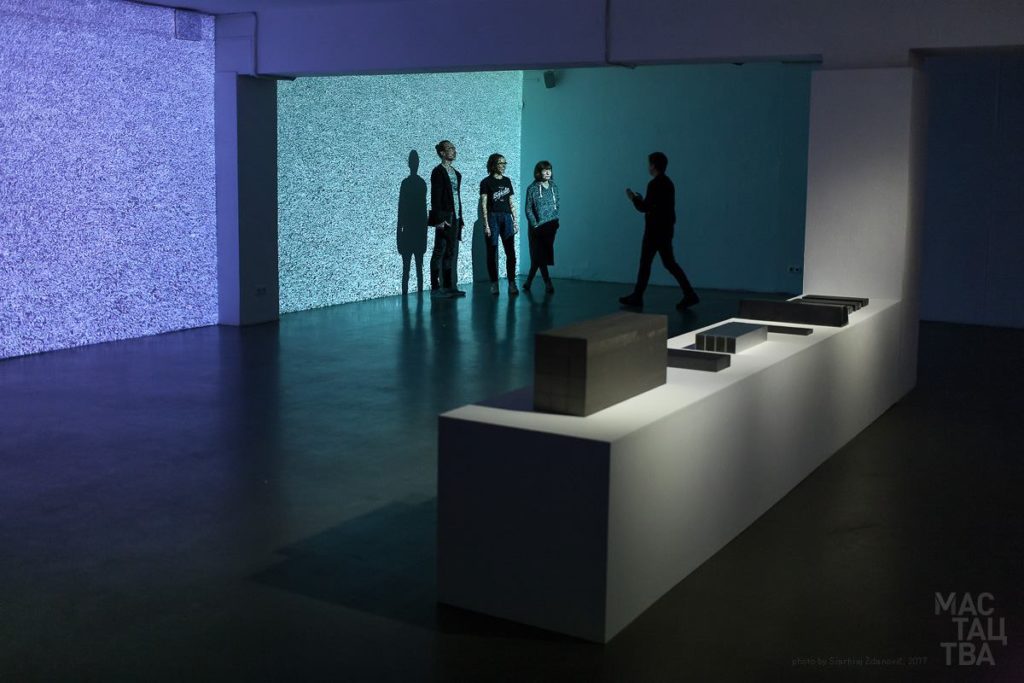
The artists’ collective behind the project ПУСТ* consists of four representatives from different artistic genres: the composer Yuri Akbalkan, the video and media artist Snezhana Vinogradova, the choreographer Alexandra Portyannikova and the visual artist Sergey Shabohin. Although the artists work with different types of media, there are similarities in their approach to art and the themes they deal with.
All four collective participants have left the academic concept of art behind them, stepping outside the limits of traditional formats in their artistic practice. Additionally, all four artists work within the framework of art in public space and incorporate elements of physicality into their work. Common themes in the artists’ respective works are archives and maps and the inclusion of political as well as historical elements.
The project ПУСТ* refers to events that took place on December 7-8, 1991, during which the presidents of Russia, Ukraine and Belarus signed the Belavezha Accords, officially dissolving the Soviet Union and the Commonwealth of Independent States.
This extremely important political event occurred in a hunting cabin in the woods of the Belavezha Forest (Belarus), the last primeval lowland forest in Europe. These events, which took place under a veil of secrecy, are still mythologized to this day. Various sources report a variety of controversial events. Some assert that the premises where the treaty was signed had been surrounded by secret services that did not intervene. Other sources state that the treaties were signed in a drunken state. There is a prevalent rumor that, once signed, the documents temporarily disappeared and were then found in the trash bin the following day. Others conjecture that the signatories feared being accused of treason and had made preparations to flee across the border to Poland by walking through the forest.
The authors of the ПУСТ* project are representative of a generation that witnessed the disintegration of the Soviet Union and thereby helped shape the historical trauma of the era.
Using artistic methods, the collective attempts to imagine the events in the Belavezha Forest from the perspective of its participants, drawing parallels between fear of the “wild forest” and fear of wild politics, between being completely adrift but also spontaneously decisive, between the enormous impact of this political decision and a series of unpredictable and absurd factors that influenced it.
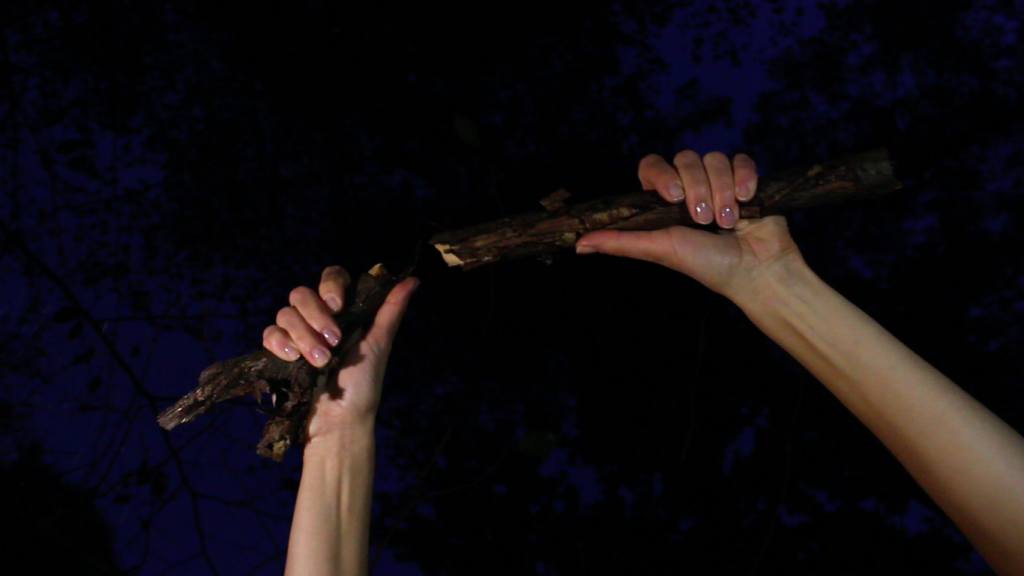
12.09–09.10.2016
Schwarzwald und ZKM | Zentrum für Kunst und Medien Karlsruhe, Germany
Team: Yuri Akbalkan, Alexandra Portyannikova,
Sergey Shabohin, Snezhana Vinogradova
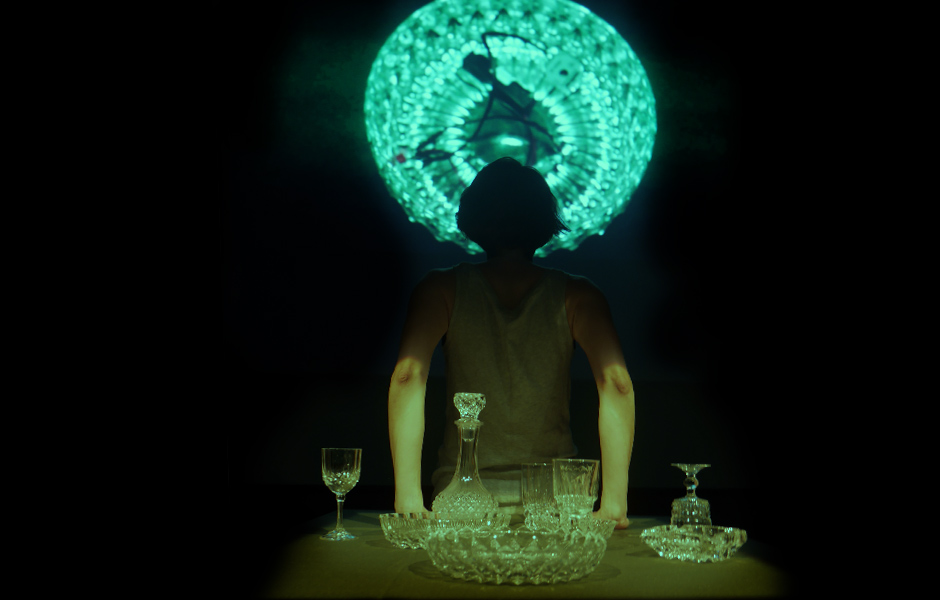
9.10.2016 / 20:00
Kubus, ZKM, Karlsruhe, Germany
Autors Team: Yuri Akbalkan, Alexandra Portyannikova, Sergey Shabohin, Snezhana Vinogradova
Team ZKM: Luise Wiesenmüller (Produktionsleitung), Hans Gass (Licht, Veranstaltungstechnik), Sebastian Schottke (Tonmeister), Matthias Müller (Tontechnik), Bernhard Sturm (Betriebstechnik), David Luchow (Assistenz Betriebstechnik), Götz Dipper (Musikinformatik), Yannick Hofmann (Künstlerbetreuung), Caro Mössner (Sekretariat), Christina Zartmann, Anna Titova (Video-Dokumentation), Anton Kossjanenko (Aufnahme)
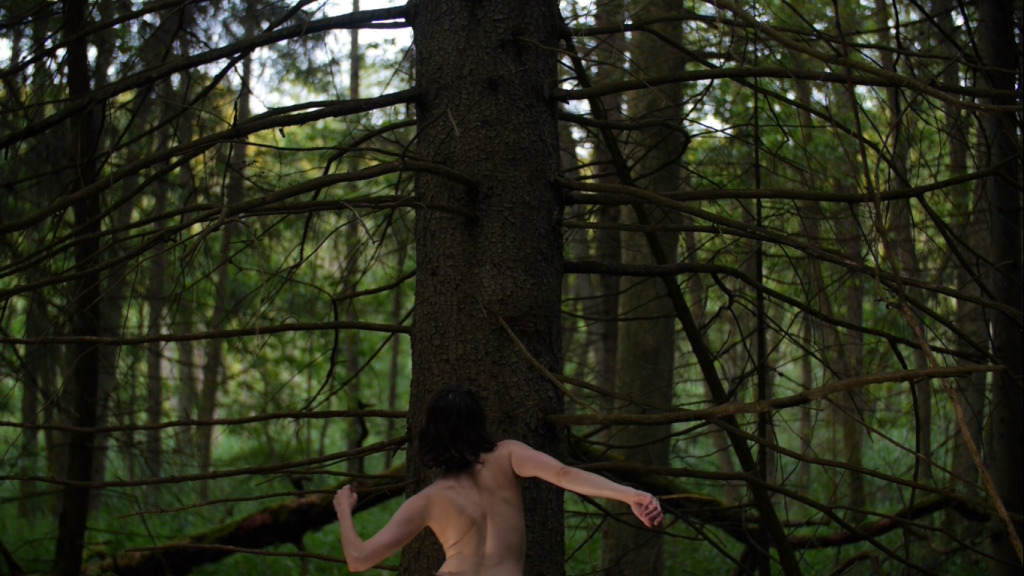
05–18.07.2017
Minsk und Białowieża-Urwald, Weißrussland
Projekt presentation in the frame of the festival „Work Hard! Play Hard! Transmission“ in Minsk
Team: Yuri Akbalkan, Daria Plokhova,
Alexandra Portyannikova, Sergey Shabohin,
Snezhana Vinogradova
Camera: Alexey Kubasov
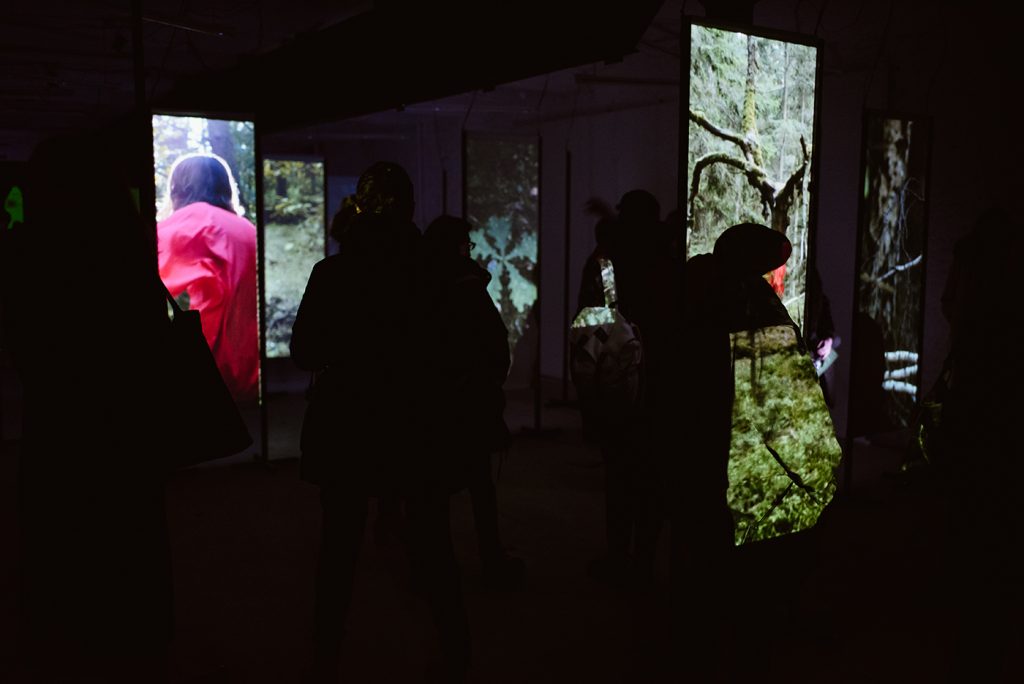
23.11.2017 / 20:00
Installation: 23–26.11.2017
Berthold-Zentrum, Saint Petersburg, Russia
Team: Yuri Akbalkan, Isadorino Gore Dance co-op (Daria Plokhova, Alexandra Portyannikova), Sergey Shabohin, VOLNA (Nikita Golyshev, Snezhana Vinogradova), Sergey Kostyrko
Idee, Design, Objekte
Sergey Shabohin
Choreografie
Konzept, Performance: Isadorino Gore Dance co-op (Daria Plokhova, Alexandra Portyannikova)
Kostüme: VOLNA
Lichtinstallation
Konzept, Produktion: VOLNA (Nikita Golyshev, Snezhana Vinogradova)
Elektronische Montageunterstützung: Nikita Savinyh
Konstruktion: VOLNA (Dmitry Gavkalyuk, Katerina Morza)
Klang
Komposition und Soundkonzept: Yuri Akbalkan
Digitaler Synthesizer Entwicklung und Programmierung: Sergey Kostyrko
Videoinstallation
Konzept, Redaktion, Produktion: VOLNA
Kamera: Alexey Kubasov, Sergey Shabohin
Projektdokumentation
Kamera: Polina Korotaeva, VOLNA
Foto: Valery Smirnov
Goethe-Institut St. Petersburg
Institutsleiter: Dr. Günther Hasenkamp
Initiatorin des Projekts, Institutsleiterin des Goethe-Institut
St. Petersburg, 2014-2017: Dr. Angelika Eder
Projektkoordinatorinnen: Jana Soboleva, Snezhana Vinogradova
ZKM | Zentrum für Kunst und Medien Karlsruhe
Leitung der Institut für Musik und Akustik: Ludger Brümmer
Licht, Veranstaltungstechnik: Hans Gass
Tonmeister: Sebastian Schottke
Tontechnik: Matthias Müller
Musikinformatik/Systemadministration: Götz Dipper
Aufnahme: Anton Kossjanenko
Betriebstechnik: Bernhard Sturm
Assistenz Betriebstechnik: David Luchov
Softwareentwicklun: Chikashi Miyama
Projekte/Veranstaltungen: Yannick Hofmann, Luise Wiesenmüller
Video-Dokumentation: Anna Titova, Christina Zartmann, Sofia Kessel
Mediaartbase.de: Daniel Höpfer
Sekretariat: Caro Mössner
Besonderer Dank
Alexey Bratochkin, William Cohen, Ksenia Diodorova, Vera Dzedok, Viktor Fiht, Justina Fink, Zhanna Gladko, Tatjana Kirianova, Beate Körner, Evgeny Korniag, Roman Krasilnikov, Klim Losovsky, Alexey Lunev, Simon Matikashvili, Pavel Preobrazhensky, Tatjana Pronina, Nemanja Sarbajic, Agata Semenova, Viktor Smolensky, Nikola Spesivtsev, Dzina Zhuk, Tatjana Zhukova
Foto:
Valeriy Smirnov (0, 9, 10, 11)
Ў Gallery (1)
Sergey Shabohin (2, 3, 4, 5, 6, 7, 8)
Alexey Kubasov (12)
VideodokumentationKamera: Polina Korotaeva
Bearbeitung: VOLNA
A detailed description of the project is available in Russian >>
for performers, video, sensor and interactive electronics
2020
15′
ricercar is the searching out composition, explores different media
It is about:
human body perception •͡˘㇁•͡˘
teddy bear ʕ•ᴥ•ʔ
barking (❍ᴥ❍ʋ)
what??? (Ͼ˳Ͽ)..!!!
square □ ■
white noise X(t)
rabbit (\-/)
zeroing 0000000
vision in toad [not found]
ghost in the machine ‹’’›(Ͼ˳Ͽ)‹’’›
It’s not about:
pacman ᗧ···ᗣ···ᗣ··
cute cats ^⨀ᴥ⨀^
birds (⌒▽⌒) ~(‾▿‾)~
domino [: :|:::]
loading ███▒▒▒▒▒▒▒
emo (///_ ; )
Harry Potter ϟ
chairs ╦╣ ╦╣ ╦╣
snails ‘-‘_@_
or even the error aesthetic (╯°□°)╯︵ ɹoɹɹƎ
…by the way, hello everybody (ʘ‿ʘ)╯
let’s play »»———————► soon!
┏(-_-)┛┗(-_- )┓┗(-_-)┛d(^o^)b¸¸♬·¯·♩¸¸♪·¯·♫¸¸
The idea behind the title related not actually to the ricercar as a genre or a type of instrumental composition, but more to the initial etymology meaning came from Italian ricercare — to seek again, seek out. It consists of the different parts within the tags: pulse (as the initial, primal sound impulse), vision in toad (as a metaphor of live organisms’ perception), barking (as a mode of the deep fear), rectangle (binary code system), short film (built in the composition and connected with the synesthesia topic), and zeroing (related to the actual for myself and my identity political topic performed as the ritual and the rabbit hole as a metaphor of endless way out).
Date of premiere: 06.07.2020
Location: reMusik.org
City, Country: St. Petersburg, Russia
Performers: Ensemble Adapter (Germany)
Matthias Engler, percussion
Kristjana Helgadóttir, alto flute
Ingólfur Vilhjálmsson, bass clarinet
Yuri Akbalkan, electronics
Commissioned by: 7th St. Petersburg International New Music Festival reMusik.org
for three performers
2013
22′

0.1. for three performers (ver. 2016)
Christian Müller (clarinet)
Cristián Alvear (guitar)
Stefan Thut (pure tone, table lamp)
06.06.2016 Biel, Switzerland, La Voirie à Biel
0.1. [двоичный код] — идея ритма, сведённая к абсолютному минимуму, мельчайшей неделимой частице, формулирующей единую прозрачную структуру: вопрос/ответ.
Date of premiere: 18.11.2013
Location: New Stage of Alexandrisky Theatre
City, Country: St. Petersburg, Russia
Performers: Moscow Contemporary Music Ensemble (MCME)
Ivan Bushuev (piccolo)
Oleg Tantsov (clarinet)
Yuri Akbalkan (pd, table lamp, timepiece)
for solo recorder 2009 1’40”
Yuri Akbalkan (recorder), Tatyana Shorokhova, Dmitri Zaytsev (audio engineers); The Rimski-Korsakov St. Petersburg State Conservatory
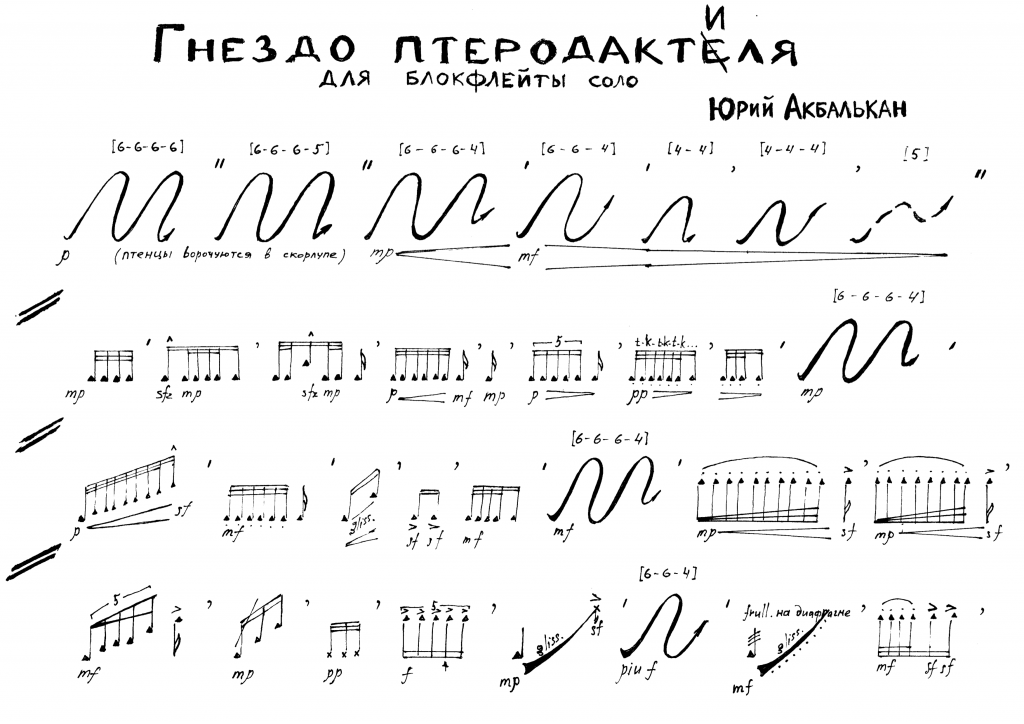

To Pterodactyl, who lived on the banks of the Volga, Undory surroundings, 120 million years ago.
Date of premiere: 23.12.2009 Location: Rimski-Korsakov St. Petersburg State Conservatory City, Country: St. Petersburg, Russia Performer: Yuri Akbalkan
for two performers
2015
11′-15′
to Eva
Ensemble Batida (Switzerland): Anne Briset (percussion, objects), Jeanne Larrouturou (percussion, objects). III St. Petersburg International New Music Festival reMusik.org, Concert Hall Jaani Kirik, Saturday, May 23nd 2015
Rose is a rose is a rose is a rose
Gertrude Stein
In generally the idea of the Rose is about little things — empty forms which connected only by their existence inside thyself; things are what they are. There are a certain quantity of little objects and instruments (toy piano, harmonica, pure tone generator, mechanical keyboard, radio, clockwork and hand cranked music box movements, small sticky tape, tuning fork) and two performers who are in dialogue with these things.
Date of premiere: 11/23.05.2015
Location: L’Abri / Concert Hall Jaani Kirik
City, Country: Geneva, Switzerland / St. Petersburg, Russia
Performers: Ensemble Batida (Switzerland)
Anne Briset (percussion, objects)
Jeanne Larrouturou (percussion, objects)
Commissioned by: III St. Petersburg International New Music Festival reMusik.org
for clarinet, cello, white noise generator and piano
2014
15′
Realization 4b: clarinet, viola and noise according to the table No. 1
Realization 4: clarinet, cello and noise according to the table No. 1 is a part of a great planned cycle under the general title Euler’s Book. As a starting point for this project served a treatise An attempt at a new theory of music, exposed in all clearness according to the most well-founded principles of harmony (lat. – Tentamen novae theoriae musicae ex certissismis harmoniae principiis dilucide expositae) created in 1739 by famous mathematician Leonhard Euler. In this treatise Euler operates with such aesthetic categories as pleasant/unpleasant, perfect/imperfect and connects with them a number of propositions of consonance and dissonance.
In Chapter XI “About harmonies of diatonic-chromatic genus” he demonstrates a table with a chain of harmonies divided into species and arranged according to their acceptability for hearing.
Every time, in the process of acoustic realization of the table, musicians should decide how to relate to a concrete harmony, building up a consonant or dissonant (from their point of view) interval, and thus revealing their personal intention in representing of beautiful and ugly. In this context, white noise is a kind of allegory, which leveling the very issue of dissonance and consonance.
Date of premiere: 11.09.2014
Location: International Young Composers Academy in Tchaikovsky city
City, Country: Tchaikovsky city, Russia
Performers: Moscow Contemporary Music Ensemble
for flute, clarinet, viola and piano
2012
10′
[versions]:
flute, clarinet, violin, piano
flute, clarinet, violin/viola, accordion
saxophone, violin, piano
Salim Javaid (saxophone), Katja Suglobina (violin), Yuri Akbalkan (piano); Institut für Neue Musik, Konzertsaal der Hochschule für Musik und Tanz Köln, June 27, 2017
Three to One [3:1] is a ratio of silence to the sound inherent in it, there being no such thing as absolute silence. It is an ambience of subtle, elusive sonorities that occasionally manifest their presence in time before being washed away by its waves, not allowing themselves to be fully heard: they thus form neume-like figures devoid of meaning and reflection.
Date of premiere: 16.12.2012
Location: The Small Hall of the Saint Petersburg Philharmonia
City, Country: St. Petersburg, Russia
Performers: ensemble recherche
Martin Fahlenbock (flute)
Shizuyo Oka (clarinet)
Barbara Maurer (viola)
Jean-Pierre Collot (piano)
for any bass instrument
2014
0’30”
Realization 3: extract bass from table No. 1a is a part of a great planned cycle under the general title Euler’s Book. As a starting point for this project served a treatise An attempt at a new theory of music, exposed in all clearness according to the most well-founded principles of harmony (lat. – Tentamen novae theoriae musicae ex certissismis harmoniae principiis dilucide expositae) created in 1739 by famous mathematician Leonhard Euler. In this treatise Euler operates with such aesthetic categories as pleasant/unpleasant, perfect/imperfect and connects with them a number of propositions of consonance and dissonance. In the Chapter XI “About harmonies of diatonic-chromatic genus” he demonstrates a table with chain of harmonies divided into species and arranged according to their acceptability for hearing. (The fragment of Euler’s table is reproduced as an addendum at the end of score).
for any keyboard instrument
2014
1′
Realization 2a: froth on the table No. 1
PianoPad
Realization 2a: froth on the table No. 1 is a part of a great planned cycle under the general title Euler’s Book. As a starting point for this project served a treatise An attempt at a new theory of music, exposed in all clearness according to the most well-founded principles of harmony (lat. – Tentamen novae theoriae musicae ex certissismis harmoniae principiis dilucide expositae) created in 1739 by famous mathematician Leonhard Euler. In this treatise Euler operates with such aesthetic categories as pleasant/unpleasant, perfect/imperfect and connects with them a number of propositions of consonance and dissonance. In the Chapter XI “About harmonies of diatonic-chromatic genus” he demonstrates a table with chain of harmonies divided into species and arranged according to their acceptability for hearing. (The fragment of Euler’s table is reproduced as an addendum at the end of score).
for performer
2012
∞
piece intended for one performer.
in all: two dice (hexahedrons).
• to twirl (to touch) a dice in one hand.
listen to the friction of dice.
as much time as needed.
• to transfer a dice to another hand. come to a stop.
the number of fallen indicates a time of silence.
each point (by default) equal to one time segment.
• to twirl (to touch) a dice in this one hand.
listen to the friction of dice.
as much time as needed.
• repeat this sequence of actions.
and further. do it over and over again.
as much time as needed.
Date of premiere: 04.05.2012
Location: Nos Mayora Kovaleva
City, Country: St. Petersburg, Russia
Performer: Kirill Shirokov
for orchestra and piano
12’/15′
Part 1: Orchestra
Orpheus Radio Symphony Orchestra
Conductor: Andrey Jakovlev
Part 2: Table No. 1
Piano: Miroslav Drobot
Realization 1: orchestra and Euler’s tables is a part of a great planned cycle under the general title Euler’s Book. As a starting point for this project served a treatise An attempt at a new theory of music, exposed in all clearness according to the most well-founded principles of harmony (lat. – Tentamen novae theoriae musicae ex certissismis harmoniae principiis dilucide expositae) created in 1739 by famous mathematician Leonhard Euler. In this treatise Euler operates with such aesthetic categories as pleasant/unpleasant, perfect/imperfect and connects with them a number of propositions of consonance and dissonance.
In the Chapter XI “About harmonies of diatonic-chromatic genus” he demonstrates a table with chain of harmonies divided into species and arranged according to their acceptability for hearing. (The fragment of Euler’s table is reproduced as an addendum at the end of score).
Piece for orchestra should to be performed simultaneously with the chains of harmonic sets from the Euler’s table in two acoustically separated spaces — for example, hall / lobby or hall / another hall; or two different stations (in case of radio broadcasting).
Date of premiere: 14.04.2014
Location: The 5th Hall of State Recordings Studio
City, Country: Moscow, Russia
Performers: Orpheus Radio Symphony Orchestra
Conductor: Andrey Jakovlev
Piano: Miroslav Drobot
Audio engineers: Tatyana Ragulskaya, Sergei Kruglov
for seven sine waves (and video)
23’10” / 40′ / 70′

Alexandra Korableva, Elizaveta Akbalkan, Maxim Chistyakov, Oleg Gudachev, Yuri Akbalkan (tone generators), Tatyana Shorokhova (audio engineer); The Rimski-Korsakov St. Petersburg State Conservatory, May 14, 2014
5.1.1. — signal type structure — five analog sine tone generators (mono) and one digital sine tone generator (stereo)
The work “5.1.1.” was originally composed for
the Pythian Games Composers’ Competition
Performed for the first time by eNsemble Pro Arte
on the New Stage of Alexandrinsky Theatre
St. Petersburg, Russia, April 25, 2014
There are also 23-, 40- and 70-minutes versions with or without video.
for two performers
2012
∞

Based on [place] by Antoine Beuger
Play any sounds at different locations of the space
Date of premiere: 05.05.2012
Location: Rimski-Korsakov St. Petersburg State Conservatory
City, Country: St. Petersburg, Russia
Performers: Yuri Akbalkan, Kirill Shirokov
for five voices
2010
ca. 3’30”
Stanislav Oporkov, Maxim Chistyakov, Elizaveta Morozova, Marina Poleukhina, Yuri Akbalkan (voices), Tatyana Shorokhova (audio engineer); The Rimski-Korsakov St. Petersburg State Conservatory
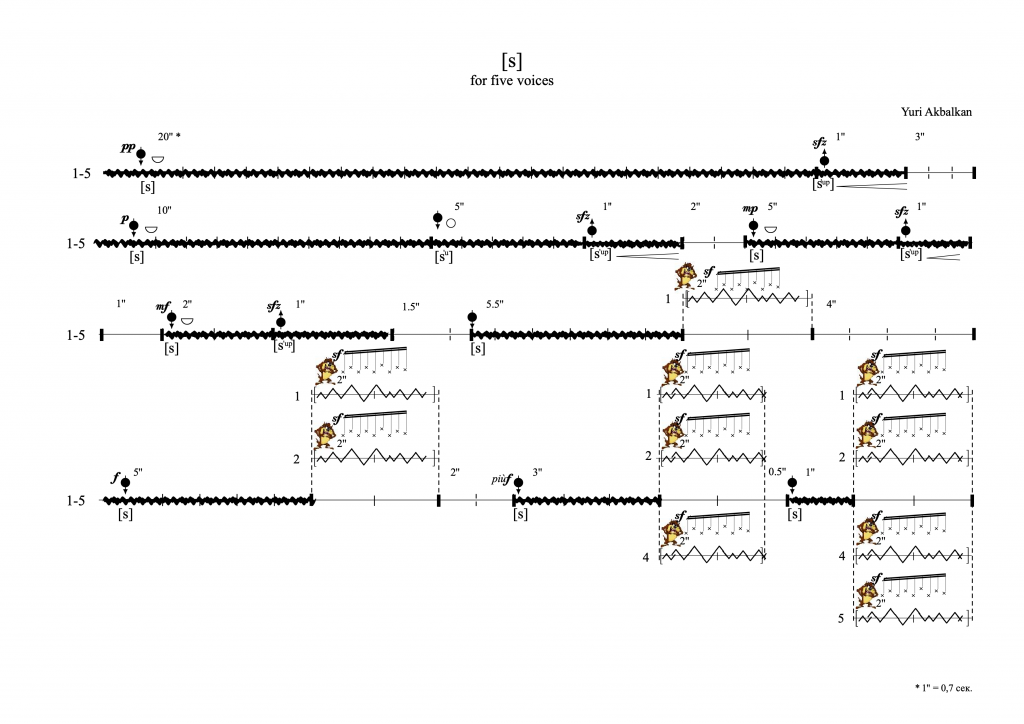
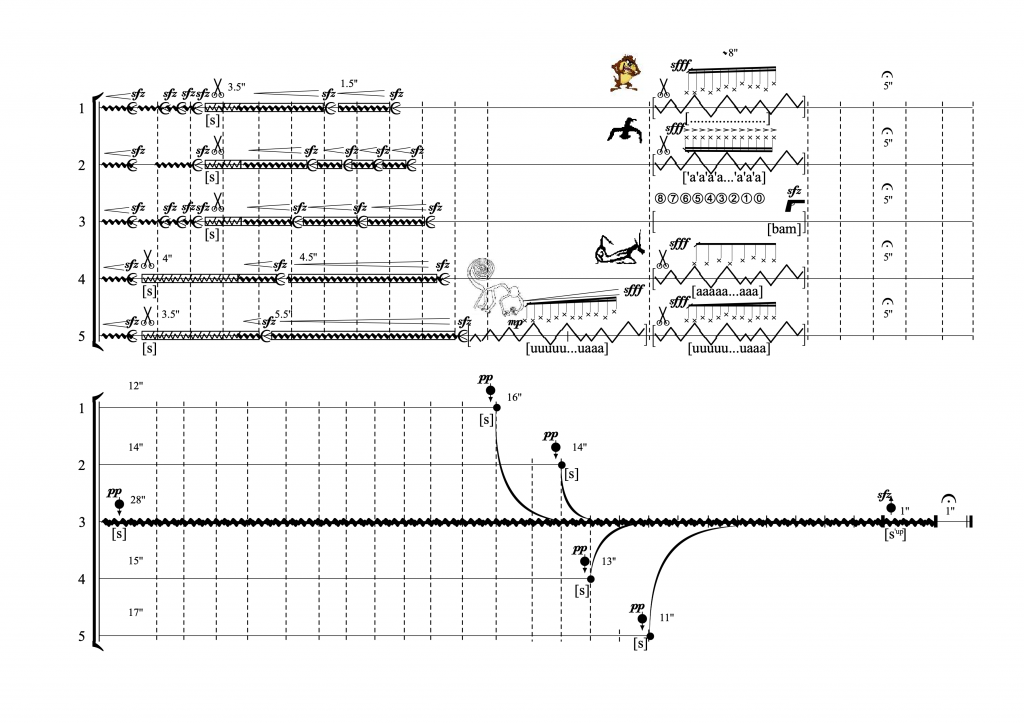
RU
Данная композиция представляет собой опыт погружения в мир одной звуковой фонемы [s] и отсылает к жанровой модели итальянского мадригала XVI века — в то время он являлся основным жанром для различных творческих экспериментов, особенно в области сочетания поэзии и музыки (в том числе, звукописи, так называемых мадригализмов), театрализации, местом испытания новых приёмов композиционной техники, категорий гармонии (особенно хроматики и микрохроматики), ритма и формы.
Date of premiere: 11.11.2010
Location: Rimski-Korsakov St. Petersburg State Conservatory
City, Country: St. Petersburg, Russia
Performers: Stanislav Oporkov, Elizaveta Morozova, Maxim Chistyakov, Marina Poleukhina, Yuri Akbalkan

